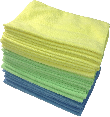Most ironing board covers are made of cotton and felt, and some covers have Teflon or silicone coating. The coating makes cleaning starch and sizing buildup easier, and will not stick to fabric. The best ironing board covers retain their shape, will not wrinkle or pucker, and are of thick construction. Today you can find reversible ironing board covers that are made with special fibers that retain and reflect heat, reducing ironing time.
But, if your ironing board cover has sizing and starch buildup, or if it is peeling or dirty, those materials can transfer quickly to the garments you iron. Each ironing board cover has a care label, just as garments do. Always follow the manufacturer's directions when cleaning an ironing board cover, but if you've lost the care label for your ironing board cover, follow these steps for cleaning it:

The Power of Microfiber! Zwipes Microfiber Cleaning Cloths will become your favorite tool for every cleaning task. This 36-cloth package is perfect for hundreds of uses in the garage, kitchen, bathroom, laundry, and all around the house. Each cloth is tough, streak-free, lint-free, reusable, and washable. Check out Microfiber Cleaning Cloths today!
Hate those unwanted creases in your jacket sleeves? Fixing that actually isn't hard and you can live without jacket creases!
Discover MoreWashing and ironing your clothes is a necessary chore and so you should just accept it and learn how to do it well. ...
Discover MoreJune Cleaver set the impossible standard of domestic perfection and believe it or not, you don't have to iron sheets, ...
Discover MoreFREE SERVICE: Get tips like this every week in Cleaning Tips from Tips.Net. Enter your address and click "Subscribe."
There are currently no comments for this tip. (Be the first to leave your comment—just use the simple form above!)
FREE SERVICE: Get tips like this every week in Cleaning Tips from Tips.Net. Enter your address and click "Subscribe."
Copyright © 2025 Sharon Parq Associates, Inc.
Comments